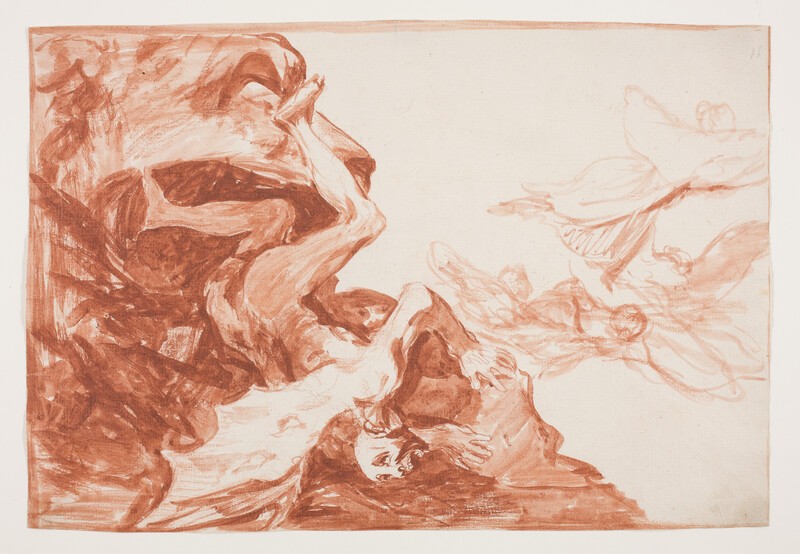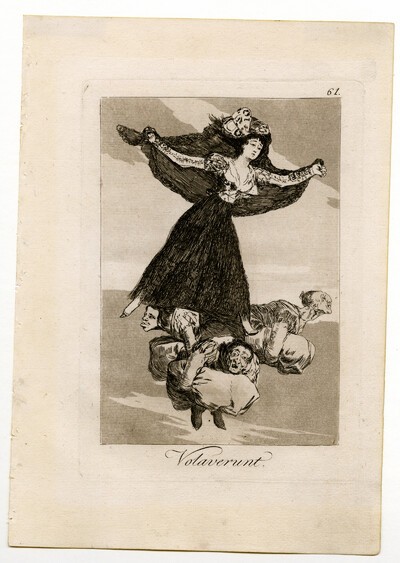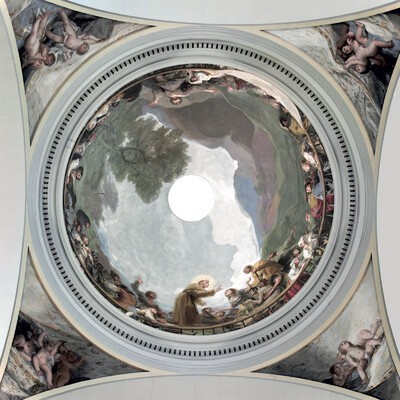- Cronología
- 1816 - 1819
- Ubicación
- The Prado National Museum. Madrid, Madrid, Spain
- Dimensiones
- 224 x 326 mm
- Técnica y soporte
- Reconocimiento de la autoría de Goya
- Documented work
- Titular
- El Prado National Museum
- Ficha: realización/revisión
- 19 Aug 2021 / 28 Apr 2023
- Inventario
- D4286
11 [reversed] (in pencil, composite, upper right corner)
200 [reversed] (in pencil, reverse, top right)
200 [on adhesive] (in pencil, reverse side, upper centre)
38 (in pencil, reverse, upper centre)
not engraved (in pencil, reverse, upper left)
MP Inventory DRAWINGS no. 200 (stamped, reverse, upper right corner)
Watermark: "MANUEL SERRA" (right half)
The drawing was inherited in 1828 by Javier Goya, the painter's son, and in 1854 by Mariano Goya y Goicoechea, the artist's grandson. It was subsequently owned by Valentín Carderera (ca. 1861) and Mariano Carderera (ca. 1880). In 1886 it was acquired from Mariano Carderera by the Directorate General of Public Instruction and was assigned to the Prado Museum, where it entered on 12 November 1886.
See People in sacks
This drawing does not correspond to any of the Follies prints but has traditionally been classified in that group because of its formal and technical similarity. The composition divides the sheet diagonally, leaving two areas of different density. On the left side, José Manuel Matilla identifies a large animal head attempting to devour the fallen figure of a winged devil. This creature, skeletal and naked, tries to cling desperately to the rocks.
He has bat-like wings and from his mouth, which shows sharp teeth, comes a cry of despair. Winged figures with diabolical faces are frequent in Goya's work, for example in the Caprices. In the sky on the right, Goya has sketched the figure of three winged women with skirts and bows in their hair, reminiscent of the protagonist of Volaverunt or the female allegories in the frescoes of Saint Anthony of La Florida in Madrid.
The difficulty of accurately interpreting the background of the scene has led various authors to reproduce the image with the composition inverted, as if the demon were climbing up a rocky slope.
-
Goya. Exposition de l’oeuvre gravé, de peintures, de tapisseries et de cent dix dessins du Musée duBibliothèque nationale de FranceParís1935
-
Goya. Das Zeitalter der Revolucionen. Kunst um 1800 (1980 – 1981)Hamburger KunsthalleHamburg1980cat. 17
-
Madrid1999
-
París2001
-
Goya en tiempos de guerraMuseo Nacional del PradoMadrid2008consultant editor Manuela B. Mena Marqués, from April 14th to July 13th 2008cat. 185
-
Goya: Luces y Sombras. Obras Maestras del Museo del PradoThe National Museum of Western ArtTokyo2011cat. 55
-
Barcelona2012cat. 75
-
Madrid2019cat. 159
-
Madrid1928p. 31, cat. 200
-
1951p. 52
-
Los dibujos de Goya, 2 vols.MadridAmigos del Museo del Prado1954s. p., cat. 396
-
OxfordBruno Cassirer1964Vol. II, p. 411, cat. 269d
-
Vie et ouvre de Francisco de GoyaParísOffice du livre1970p. 327, cat. 1608
-
Dibujos de Goya, 2 volsBarcelonaNoguer1975pp. 464-465, cat. 306
-
Goya, Das Zeitalter de Revolutionen. 1789-1830HamburgPrestel-Verlag Münche und Hamburger Kunsthalle1980p. 70
-
Roma Edizioni de Luca2000pp. 146-147, cat. 51
-
MadridEdiciones el Viso, Museo Nacional del Prado2008pp. 494-495, cat. 185
-
MadridMuseo Nacional del Prado2019p. 247


